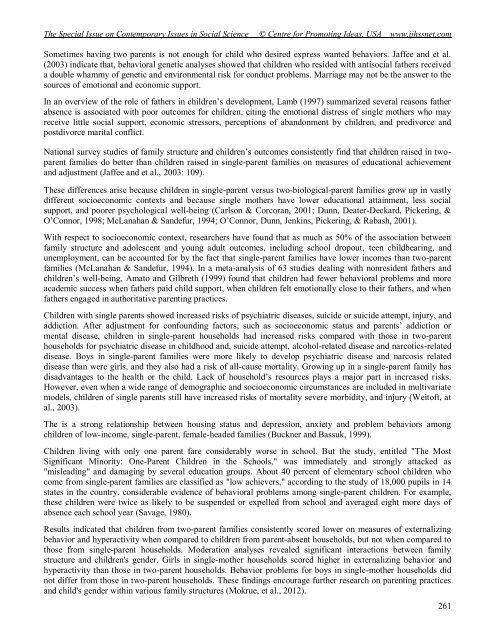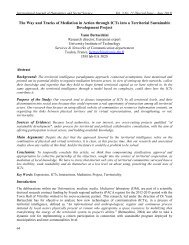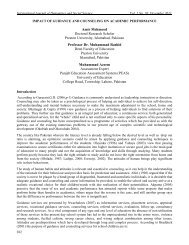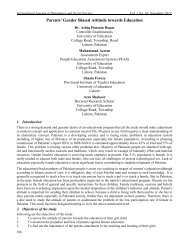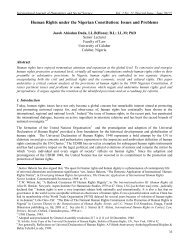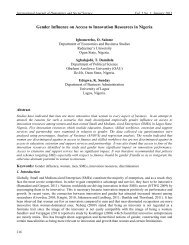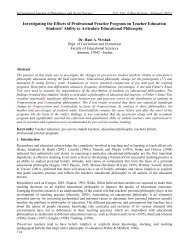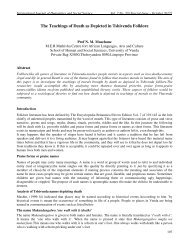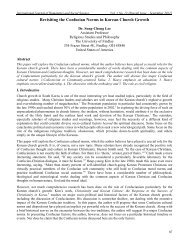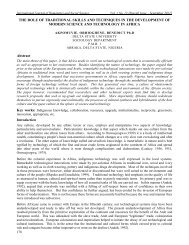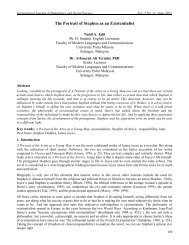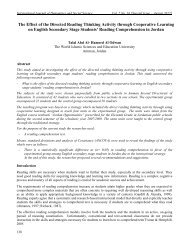Comparison of Single and Two Parents Children in terms of ...
Comparison of Single and Two Parents Children in terms of ...
Comparison of Single and Two Parents Children in terms of ...
You also want an ePaper? Increase the reach of your titles
YUMPU automatically turns print PDFs into web optimized ePapers that Google loves.
The Special Issue on Contemporary Issues <strong>in</strong> Social Science<br />
© Centre for Promot<strong>in</strong>g Ideas, USA www.ijhssnet.com<br />
Sometimes hav<strong>in</strong>g two parents is not enough for child who desired express wanted behaviors. Jaffee <strong>and</strong> et al.<br />
(2003) <strong>in</strong>dicate that, behavioral genetic analyses showed that children who resided with antisocial fathers received<br />
a double whammy <strong>of</strong> genetic <strong>and</strong> environmental risk for conduct problems. Marriage may not be the answer to the<br />
sources <strong>of</strong> emotional <strong>and</strong> economic support.<br />
In an overview <strong>of</strong> the role <strong>of</strong> fathers <strong>in</strong> children‟s development, Lamb (1997) summarized several reasons father<br />
absence is associated with poor outcomes for children, cit<strong>in</strong>g the emotional distress <strong>of</strong> s<strong>in</strong>gle mothers who may<br />
receive little social support, economic stressors, perceptions <strong>of</strong> ab<strong>and</strong>onment by children, <strong>and</strong> predivorce <strong>and</strong><br />
postdivorce marital conflict.<br />
National survey studies <strong>of</strong> family structure <strong>and</strong> children‟s outcomes consistently f<strong>in</strong>d that children raised <strong>in</strong> twoparent<br />
families do better than children raised <strong>in</strong> s<strong>in</strong>gle-parent families on measures <strong>of</strong> educational achievement<br />
<strong>and</strong> adjustment (Jaffee <strong>and</strong> et al., 2003: 109).<br />
These differences arise because children <strong>in</strong> s<strong>in</strong>gle-parent versus two-biological-parent families grow up <strong>in</strong> vastly<br />
different socioeconomic contexts <strong>and</strong> because s<strong>in</strong>gle mothers have lower educational atta<strong>in</strong>ment, less social<br />
support, <strong>and</strong> poorer psychological well-be<strong>in</strong>g (Carlson & Corcoran, 2001; Dunn, Deater-Deckard, Picker<strong>in</strong>g, &<br />
O‟Connor, 1998; McLanahan & S<strong>and</strong>efur, 1994; O‟Connor, Dunn, Jenk<strong>in</strong>s, Picker<strong>in</strong>g, & Rabash, 2001).<br />
With respect to socioeconomic context, researchers have found that as much as 50% <strong>of</strong> the association between<br />
family structure <strong>and</strong> adolescent <strong>and</strong> young adult outcomes, <strong>in</strong>clud<strong>in</strong>g school dropout, teen childbear<strong>in</strong>g, <strong>and</strong><br />
unemployment, can be accounted for by the fact that s<strong>in</strong>gle-parent families have lower <strong>in</strong>comes than two-parent<br />
families (McLanahan & S<strong>and</strong>efur, 1994). In a meta-analysis <strong>of</strong> 63 studies deal<strong>in</strong>g with nonresident fathers <strong>and</strong><br />
children‟s well-be<strong>in</strong>g, Amato <strong>and</strong> Gilbreth (1999) found that children had fewer behavioral problems <strong>and</strong> more<br />
academic success when fathers paid child support, when children felt emotionally close to their fathers, <strong>and</strong> when<br />
fathers engaged <strong>in</strong> authoritative parent<strong>in</strong>g practices.<br />
<strong>Children</strong> with s<strong>in</strong>gle parents showed <strong>in</strong>creased risks <strong>of</strong> psychiatric diseases, suicide or suicide attempt, <strong>in</strong>jury, <strong>and</strong><br />
addiction. After adjustment for confound<strong>in</strong>g factors, such as socioeconomic status <strong>and</strong> parents‟ addiction or<br />
mental disease, children <strong>in</strong> s<strong>in</strong>gle-parent households had <strong>in</strong>creased risks compared with those <strong>in</strong> two-parent<br />
households for psychiatric disease <strong>in</strong> childhood <strong>and</strong>, suicide attempt, alcohol-related disease <strong>and</strong> narcotics-related<br />
disease. Boys <strong>in</strong> s<strong>in</strong>gle-parent families were more likely to develop psychiatric disease <strong>and</strong> narcosis related<br />
disease than were girls, <strong>and</strong> they also had a risk <strong>of</strong> all-cause mortality. Grow<strong>in</strong>g up <strong>in</strong> a s<strong>in</strong>gle-parent family has<br />
disadvantages to the health or the child. Lack <strong>of</strong> household‟s resources plays a major part <strong>in</strong> <strong>in</strong>creased risks.<br />
However, even when a wide range <strong>of</strong> demographic <strong>and</strong> socioeconomic circumstances are <strong>in</strong>cluded <strong>in</strong> multivariate<br />
models, children <strong>of</strong> s<strong>in</strong>gle parents still have <strong>in</strong>creased risks <strong>of</strong> mortality severe morbidity, <strong>and</strong> <strong>in</strong>jury (Weit<strong>of</strong>t, at<br />
al., 2003).<br />
The is a strong relationship between hous<strong>in</strong>g status <strong>and</strong> depression, anxiety <strong>and</strong> problem behaviors among<br />
children <strong>of</strong> low-<strong>in</strong>come, s<strong>in</strong>gle-parent, female-headed families (Buckner <strong>and</strong> Bassuk, 1999).<br />
<strong>Children</strong> liv<strong>in</strong>g with only one parent fare considerably worse <strong>in</strong> school. But the study, entitled "The Most<br />
Significant M<strong>in</strong>ority: One-Parent <strong>Children</strong> <strong>in</strong> the Schools," was immediately <strong>and</strong> strongly attacked as<br />
"mislead<strong>in</strong>g" <strong>and</strong> damag<strong>in</strong>g by several education groups. About 40 percent <strong>of</strong> elementary school children who<br />
come from s<strong>in</strong>gle-parent families are classified as "low achievers," accord<strong>in</strong>g to the study <strong>of</strong> 18,000 pupils <strong>in</strong> 14<br />
states <strong>in</strong> the country. considerable evidence <strong>of</strong> behavioral problems among s<strong>in</strong>gle-parent children. For example,<br />
these children were twice as likely to be suspended or expelled from school <strong>and</strong> averaged eight more days <strong>of</strong><br />
absence each school year (Savage, 1980).<br />
Results <strong>in</strong>dicated that children from two-parent families consistently scored lower on measures <strong>of</strong> externaliz<strong>in</strong>g<br />
behavior <strong>and</strong> hyperactivity when compared to children from parent-absent households, but not when compared to<br />
those from s<strong>in</strong>gle-parent households. Moderation analyses revealed significant <strong>in</strong>teractions between family<br />
structure <strong>and</strong> children's gender. Girls <strong>in</strong> s<strong>in</strong>gle-mother households scored higher <strong>in</strong> externaliz<strong>in</strong>g behavior <strong>and</strong><br />
hyperactivity than those <strong>in</strong> two-parent households. Behavior problems for boys <strong>in</strong> s<strong>in</strong>gle-mother households did<br />
not differ from those <strong>in</strong> two-parent households. These f<strong>in</strong>d<strong>in</strong>gs encourage further research on parent<strong>in</strong>g practices<br />
<strong>and</strong> child's gender with<strong>in</strong> various family structures (Mokrue, et al., 2012).<br />
261


